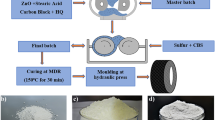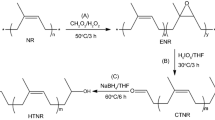Abstract
The filler-rubber interaction and filler dispersion in natural rubber composites are important factors in determining the properties. Herein, an inorganic–organic hybrid filler was synthesized by attachment of styrene oxide to the surface of alpha zirconium phosphate nanoplatelets, and then it was incorporated in natural rubber/carbon black composites. The effect of surface modified zirconium phosphate on the morphology, thermal and mechanical properties of the composites were investigated using the scanning electron microscope, thermal gravimetric analysis, tensile tests and dynamic mechanical analysis. The scanning electron microscope analysis indicates that surface modified zirconium phosphate greatly improved the dispersion of carbon black in the composites. The addition of surface modified zirconium phosphate leads to the improvement of the abrasion resistance, tensile strength, elongation at break and dynamic mechanical properties of the composites. Furthermore, the low content of surface modified zirconium phosphate significantly improved the abrasion resistance, wet grip resistance and decreased rolling resistance of the composites.












Similar content being viewed by others
Data availability
The datasets used and/or analysed during the current study are available from the corresponding author on reasonable request.
References
Rajan KP, Gopanna A, Theravalappil R, Abdelghani EA, Thomas SP (2022) Partial replacement of carbon black with graphene in natural rubber/butadiene rubber based tire compound: Investigation of critical properties. J Polym Res 29:1–17
Jung J, Sodano HA (2020) Aramid nanofiber reinforced rubber compounds for the application of tire tread with high abrasion resistance and fuel saving efficiency. ACS Appl Polym Mater 2:4874–4884
Nair V, Kumar K, Subramaniam C (2019) Mechanochemically controlling the van der Waals gap in molybdenum disulfide nanosheets. Phys Rev Mater 3:015802
Ten Brinke J, Debnath S, Reuvekamp LA, Noordermeer JW (2003) Mechanistic aspects of the role of coupling agents in silica–rubber composites. Compos Sci Technol 63:1165–1174
Ramesan M (2005) The effects of filler content on cure and mechanical properties of dichlorocarbene modified styrene butadiene rubber/carbon black composites. J Polym Res 11:333–340
Sattayanurak S, Sahakaro K, Kaewsakul W, Dierkes WK, Reuvekamp LA, Blume A, Noordermeer JW (2020) Synergistic effect by high specific surface area carbon black as secondary filler in silica reinforced natural rubber tire tread compounds. Polym Test 81:106173
Al-Ghamdi AA, Al-Hartomy OA, Al-Solamy FR, Dishovsky N, Mihaylov M, Atanasov N, Atanasova G, Nihtianova D (2016) Microwave properties of natural rubber based composites comprising conductive carbon black/silica hybrid fillers. J Polym Res 23:1–12
Liu Y, Li L, Wang Q, Zhang X (2011) Fracture properties of natural rubber filled with hybrid carbon black/nanoclay. J Polym Res 18:859–867
Romyen N, Thongyai S, Praserthdam P (2010) Surfactant-dispersed carbon black in polyimide nanocomposites: Spectroscopic monitoring of the dispersion state in the polymer matrix. J Appl Polym Sci 115:1622–1629
Kang S, Jones AR, Moore JS, White SR, Sottos NR (2014) Microencapsulated carbon black suspensions for restoration of electrical conductivity. Adv Funct Mater 24:2947–2956
Lei Y, Guo B, Liu X, Jia D (2009) Structure evolution of carbon black under ionic-liquid-assisted microwave irradiation. Appl Surf Sci 255:8488–8493
Nawani P, Burger C, Rong L, Hsiao BS, Tsou AH (2015) Structure and permeability relationships in polymer nanocomposites containing carbon black and organoclay. Polym 64:19–28
Ayippadath Gopi J, Patel SK, Chandra AK, Tripathy DK (2011) SBR-clay-carbon black hybrid nanocomposites for tire tread application. J Polym Res 18:1625–1634
Spratte T, Plagge J, Wunde M, Klüppel M (2017) Investigation of strain-induced crystallization of carbon black and silica filled natural rubber composites based on mechanical and temperature measurements. Polym 115:12–20
Gao J, He Y, Gong X, Xu J (2017) The role of carbon nanotubes in promoting the properties of carbon black-filled natural rubber/butadiene rubber composites. Results Phys 7:4352–4358
Wu X, Lu C, Han Y, Zhou Z, Yuan G, Zhang X (2016) Cellulose nanowhisker modulated 3D hierarchical conductive structure of carbon black/natural rubber nanocomposites for liquid and strain sensing application. Compos Sci Technol 124:44–51
Valentini L, Bon SB, López-Manchado MA, Verdejo R, Pappalardo L, Bolognini A, Alvino A, Borsini S, Berardo A, Pugno N (2016) Synergistic effect of graphene nanoplatelets and carbon black in multifunctional EPDM nanocomposites. Compos Sci Technol 128:123–130
Ravikumar K, Palanivelu K,Ravichandran K (2015) Vulcanization, mechanical and dielectric properties of carbon black/nanoclay reinforced natural rubber hybrid composites. Appl Mech Mater. Trans Tech Publications
Kim S, Yoo H (2021) Self-assembled monolayers: Versatile uses in electronic devices from gate dielectrics, dopants, and biosensing linkers. Micromachines 12:565
Surya I, Muniyadi M, Ismail H (2021) A review on clay-reinforced ethylene propylene diene terpolymer composites. Polym Compos 42:1698–1711
Zhu Z, Baker J, Liu C, Zhao M, Kotaki M, Sue H-J (2021) High performance epoxy nanocomposites based on dual epoxide modified α-Zirconium phosphate nanoplatelets. Polym 212:123154
Clearfield A, Duax W, Medina A, Smith GD, Thomas J (1969) Mechanism of ion exchange in crystalline zirconium phosphates. I. Sodium ion exchange of. alpha.-zirconium phosphate. J Phys Chem 73:3424–3430
Terban MW, Shi C, Silbernagel R, Clearfield A, Billinge SJ (2017) Local environment of terbium (III) ions in layered nanocrystalline zirconium (IV) phosphonate–phosphate ion exchange materials. Inorg Chem 56:8837–8846
Najafi H, Farajfaed S, Zolgharnian S, Mirak SHM, Asasian-Kolur N, Sharifian S (2021) A comprehensive study on modified-pillared clays as an adsorbent in wastewater treatment processes. Process Saf Environ Prot 147:8–36
Casciola M, Alberti G, Donnadio A, Pica M, Marmottini F, Bottino A, Piaggio P (2005) Gels of zirconium phosphate in organic solvents and their use for the preparation of polymeric nanocomposites. J Mater Chem 15:4262–4267
Cruz E, Broker EJ, Mosby BM (2020) Combination of intercalation and surface modification in layered zirconium phosphates: investigation of surface stability and reactivity. Dalton Trans 49:3841–3848
Boo WJ, Sun L, Liu J, Clearfield A, Sue H-J (2007) Effective intercalation and exfoliation of nanoplatelets in epoxy via creation of porous pathways. J Phys Chem C 111:10377–10381
Bongiovanni R, Casciola M, Di Gianni A, Donnadio A, Malucelli G (2009) Epoxy-nanocomposites containing exfoliated zirconium phosphate: Preparation via cationic photopolymerisation and physicochemical characterisation. Eur Polym J 45:2487–2493
Sun L, Boo WJ, Sue H-J, Clearfield A (2007) Preparation of α-zirconium phosphate nanoplatelets with wide variations in aspect ratios. New J Chem 31:39–43
Wang H, Zou M, Li N, Li K (2007) Preparation and characterization of ionic liquid intercalation compounds into layered zirconium phosphates. J mater sci 42:7738–7744
Haiyan W, Daxiong H, Na L, Ke-An L (2005) Study on the intercalation and interlayer state of porphyrins into α-zirconium phosphate. J Incl Phenom 52:247–252
Zhang H, Li K, Wang M, Zhang J (2021) The preparation of a composite flame retardant of layered double hydroxides and α-zirconium phosphate and its modification for epoxy resin. Mater Today Commun 28:102711
Xing W, Song L, Lv X, Wang X, Hu Y (2011) Preparation, combustion and thermal behaviors of UV-cured coatings containing organically modified α-ZrP. J Polym Res 18:179–185
Ou J, Ge C, Kong Z, Chen Y, Dai Z (2020) Synthesis of a novel α-zirconium phosphate and investigation of influence on thermal stability of addition cured silicon rubber. J Therm Anal Calorim 139:2079–2087
Liu T, Zeng X, Lai X, Li H, Wu T (2019) Improvement of platinum nanoparticles-immobilized α-zirconium phosphate sheets on tracking and erosion resistance of silicone rubber. Compos B Eng 176:107203
Brandão LS, Mendes LC, Medeiros ME, Sirelli L, Dias ML (2006) Thermal and mechanical properties of poly (ethylene terephthalate)/lamellar zirconium phosphate nanocomposites. J Appl Polym Sci 102:3868–3876
Kale MB, Divakaran N, Mubarak S, Dhamodharan D, Senthil T, Wu L (2020) Waterborne polyurethane nanocomposite reinforced with amine intercalated α-zirconium phosphate-Study of thermal and mechanical properties. Polym 186:122008
Freitas DF, Mattos GC, Mendes LC (2021) Investigation on miscibility, thermal, crystallographic diffraction and dynamic-mechanical properties of poly (vinyl alcohol)/poly (vinylpyrrolidone)/zirconium phosphate nanocomposites. J Therm Anal Calorim 145:319–329
Mosby BM, Díaz A, Bakhmutov V, Clearfield A (2013) Surface functionalization of zirconium phosphate nanoplatelets for the design of polymer fillers. ACS Appl Mater Interfaces 6:585–592
Harrold ND, Li Y, Chisholm MH (2013) Studies of ring-opening reactions of styrene oxide by chromium tetraphenylporphyrin initiators. Mechanistic and stereochemical considerations Macromolecules 46:692–698
Gérard J, Espuche E (2012) Modification of α-ZrP nanofillers by amines of different chain length: Consequences on the morphology and mechanical properties of styrene butadiene rubber based nanocomposites. Eur Polym J 48:217–227
Dal Pont K, Gérard JF, Espuche E (2013) Microstructure and properties of styrene-butadiene rubber based nanocomposites prepared from an aminosilane modified synthetic lamellar nanofiller. J Polym Sci B Polym Phys 51:1051–1059
Krogh Andersen AM, Norby P, Hanson JC, Vogt T (1998) Preparation and characterization of a new 3-dimensional zirconium hydrogen phosphate, τ-Zr (HPO4)2. Determination of the complete crystal structure combining synchrotron X-ray single-crystal diffraction and neutron powder diffraction. Inorg Chem 37:876–881
Clearfield A, Costantino U (1996) In solid-state supramolecular chemistry: Two- and three-dimensional inorganic networks, 1st ed.; Alberti G, Bein T (Eds) Pergamon Press: Oxford, 7:111−112
Liu Y, Lu C, Hou W, Zhu J-J (2008) Direct electron transfer of hemoglobin in layered α-zirconium phosphate with a high thermal stability. Anal Biochem 375:27–34
Horsley S, Nowell D, Stewart D (1974) The infrared and Raman spectra of α-zirconium phosphate. Spectrochim Acta A Mol Biomol Spectrosc 30:535–541
Patel H, Chudasama UMA (2007) A comparative study of proton transport properties of metal (IV) phosphates. J Chem Sci 119(1):35–40
Clearfield A, Pack S (1975) Factors determining ion exchange selectivity—I high temperature phases formed by α-zirconium phosphate and its sodium and potassium exchanged forms. J Inorg Nucl Chem 37:1283–1290
Sharif J, Yunus WMZW, Dahlan KZHM, Ahmad MH (2005) Preparation and properties of radiation crosslinked natural rubber/clay nanocomposites. Polym Test 24:211–217
Mishra S, Shimpi N, Patil U (2007) Effect of nano CaCO3 on thermal properties of styrene butadiene rubber (SBR). J Polym Res 14:449–459
Contreras-Ramirez A, Tao S, Day GS, Bakhmutov VI, Billinge SJ, Zhou H-C (2019) Zirconium phosphate: the pathway from Turbostratic disorder to crystallinity. Inorg Chem 58:14260–14274
Somasekharan L, Xavier P, Bose S, Zachariah AK, Kalarikkal N, Anil Kumar S, Thomas S (2020) Natural rubber nanocomposites with MWCNT@ POSS hybrid filler: Preparation and properties. Polym Compos 41:369–380
Wang W, Zhang Y, Zhang Y, Sun J (2022) Activated calcium silicate/natural rubber composites prepared via latex compounding: Static and dynamic mechanical properties. J Polym Res 29:1–17
Kueseng P, Sae-Oui P, Sirisinha C, Jacob KI, Rattanasom N (2013) Anisotropic studies of multi-wall carbon nanotube (MWCNT)-filled natural rubber (NR) and nitrile rubber (NBR) blends. Polym Test 32:1229–1236
Yu P, He H, Jia Y, Tian S, Chen J, Jia D, Luo Y (2016) A comprehensive study on lignin as a green alternative of silica in natural rubber composites. Polym Test 54:176–185
Kapgate BP, Das C (2014) Reinforcing efficiency and compatibilizing effect of sol–gel derived in situ silica for natural rubber/chloroprene rubber blends. RSC Adv 4:58816–58825
Tk S, Naskar K (2021) Zinc oxide with various surface characteristics and its role on mechanical properties, cure-characteristics, and morphological analysis of natural rubber/carbon black composites. J Polym Res 28:1–14
Bahl K, Miyoshi T, Jana SC (2014) Hybrid fillers of lignin and carbon black for lowering of viscoelastic loss in rubber compounds. Polym 55:3825–3835
Rattanasom N, Ta S, Deeprasertkul C (2007) Reinforcement of natural rubber with silica/carbon black hybrid filler. Polym Test 26:369–377
Author information
Authors and Affiliations
Corresponding author
Ethics declarations
Conflicts of interest
All authors declare that they have no conflicts of interest.
Additional information
Publisher's Note
Springer Nature remains neutral with regard to jurisdictional claims in published maps and institutional affiliations.
Supplementary Information
Below is the link to the electronic supplementary material.
Rights and permissions
Springer Nature or its licensor (e.g. a society or other partner) holds exclusive rights to this article under a publishing agreement with the author(s) or other rightsholder(s); author self-archiving of the accepted manuscript version of this article is solely governed by the terms of such publishing agreement and applicable law.
About this article
Cite this article
Haq, Z.U., Jiang, Y., Zia-ul-Haq, M. et al. Surface modified alpha zirconium phosphate (α-ZrP) reinforced natural rubber composites for tire tread application. J Polym Res 30, 121 (2023). https://doi.org/10.1007/s10965-023-03502-2
Received:
Accepted:
Published:
DOI: https://doi.org/10.1007/s10965-023-03502-2




